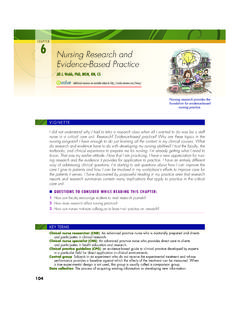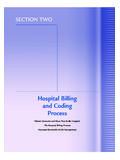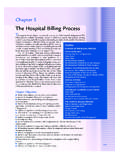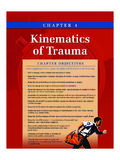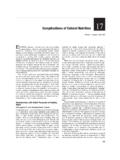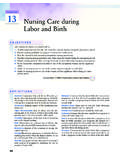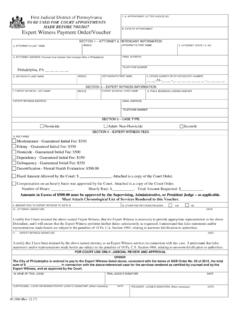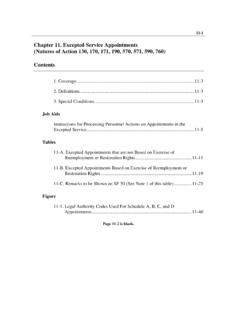Transcription of Scheduling Appointments - Coursewareobjects.com
1 956 CHAPTER 40 Scheduling Appointments95640 Scheduling AppointmentsLEARNING OBJECTIVESPROCEDURESM ethods of Scheduling1. Explain why Scheduling Appointments effi ciently is crucial to the smooth operation of the medical offi Describe the correct use of appointment books and computer Scheduling to make Describe the legal implications of the daily appointment of Scheduling1. Describe several types of Scheduling including stream Scheduling , double booking, wave, modifi ed wave, and open Identify types of patient Appointments that may be clustered in the appointment Up the appointment Matrix1. Identify factors to be considered when setting up the appointment up the appointment List the steps in setting up the appointment an Appointment1. Differentiate between the information needed to make an appointment for a new patient and an established an Differentiate between medical conditions that require emergency care, urgent care, and routine Describe how to schedule Appointments for individuals who are not the appointment Schedule1.
2 Describe the method for changing or canceling the appointment Describe how to update the schedule on the day of the appointment and document Identify three methods to remind patients to make or keep Describe how to store appointment books and daily Referral Appointments , Diagnostic Tests, Procedures, and Admissions1. Describe how to complete referral forms and obtain a referral form for managed Identify how to schedule outpatient and outpatient diagnostic tests and inpatient or outpatient diagnostic tests or Identify how to schedule hospital admissions and inpatient or outpatient 9567/17/2008 11:08:37 AM7/17/2008 11:08:37 AM957 CHAPTER 40 Scheduling AppointmentsCHAPTER OUTLINEI ntroduction to appointment SchedulingGuidelines for appointment SchedulingMethods of SchedulingAppointment Book SchedulingComputer SchedulingDaily appointment ScheduleTypes of SchedulingTime-Specifi ed (Stream)
3 SchedulingWave SchedulingModifi ed Wave SchedulingDouble BookingOpen BookingClustering or CategorizationMultiple Offi cesSetting Up the appointment MatrixAppointment IntervalsPhysician s Preference and NeedsFacilities and Equipment Requirements957 Guidelines for SchedulingEstablished PatientsNew Patients and ReferralsSame-Day AppointmentsUrgent Care and EmergenciesWalk-in PatientsIndividuals Who Are Not PatientsManaging the appointment ScheduleChanging AppointmentsLate PatientsAppointment RemindersStoring appointment Books and Daily SchedulesScheduling Referral Appointments , Diagnostic Tests, Procedures, and AdmissionsReferrals and PreauthorizationsScheduling Diagnostic Procedures and Hospital AdmissionsScheduling SurgeryCAAHEP COMPETENCIESA dministrative CompetenciesPerform Clerical Functions Schedule and manage Appointments .
4 Schedule inpatient and outpatient admissions and CompetenciesPatient Care Perform telephone and in-person CompetenciesProfessional Communication Respond to and initiate written communications. Recognize and respond to verbal communications. Demonstrate telephone Concepts Identify and respond to issues of confi dentiality. Perform within legal and ethical boundaries. Document appropriately. Demonstrate knowledge of federal and state health care legislation and Instruction Explain general offi ce Functions Use computer software to maintain offi ce COMPETENCIESP rofessionalism Maintain confi dentiality at all times. Be courteous and Use proper telephone techniques. Recognition and response to verbal and nonverbal communication. Application of electronic technology.
5 Fundamental writing Duties Perform basic secretarial skills. Schedule and monitor Appointments . Apply computer concepts for offi ce procedures. Schedule inpatient and outpatient admissions. Obtain managed care referrals and precertifi Concepts Document accurately. Follow established policy in initiating or terminating Orient patients to offi ce policies and 9577/17/2008 11:08:40 AM7/17/2008 11:08:40 AM958 CHAPTER 40 Scheduling Appointments958 KEY TERMS blockedclusteringdouble bookingestablished patientfi xed appointment schedulinghospicematrix (MAY-trix)modifi ed wave schedulingnew patientno-showpreadmission testing (PAT)preauthorization (PREE-awe-thur-eye-zay-shun)referralsing le bookingstream schedulingtime-specifi ed schedulingtriage (TREE-ahzh)wave schedulingIntroduction to appointment SchedulingScheduling Appointments is one of the most important administrative responsibilities performed in the medical offi ce.
6 Until the 1970s, people went to a medical offi ce expecting to wait as long as an hour or more. Most physi-cians liked to see a full waiting room; it reassured them that their practice was into the new century, people have little tolerance for waiting in a medical offi ce. Lifestyles have changed and people have busy lives. Many have to take personal time away from work to go to the medical offi ce, and they feel that their time is as valuable as the physician s Appointments correctly and effi ciently is crucial to the smooth operation of the medical offi ce. Many factors must be taken into consideration when Scheduling Appointments . The patient who has made an appointment weeks or even months in advance wants to be seen within 15 to 20 minutes after arriving at the medical offi ce.
7 The physician wants a smooth fl ow of patients during the time scheduled for seeing patients. Patients who are ill or have accidents want to be able to see their physician on the day of the illness or injury. They prefer to be given a specifi c time, even if it is later in the day, rather than come into the offi ce and wait for an open FOR appointment SCHEDULINGThe most important criteria the medical assistant must take into consideration when Scheduling Appointments are exhibiting good interpersonal skills and reducing the amount of time a patient has to wait to see the physician. To meet these criteria, the medical assistant should follow seven guidelines:1. Maintain the confi dentiality of the patient. For example, do not discuss protected health information within hearing distance of other Speak clearly and do not appear rushed.
8 Make sure the tone of your voice is friendly and Concentrate only on the person to whom you are Obtain all of the necessary information from the pa-tient. Make sure the information is both correct and Repeat the information relayed to you by the patient. This avoids Schedule the proper amount of time for the type of appointment you are Scheduling . For example, a new patient requires more time than an established Document all of the necessary information correctly in the appointment book or in the computer appointment Scheduling OF SCHEDULINGTwo methods are used to schedule Appointments . Appoint-ments can be scheduled manually, using an appoint-ment book. They can also be scheduled electronically using a computer. These methods are described in more detail Book SchedulingAppointment books are usually spiral-bound, so they will lie fl at when opened (Figure 40-1).
9 Each physician in the practice may have a separate book, or one book may serve the needs of two or more physicians. appointment books are available in the following formats: pages for a single day, pages that display a week when open (over two pages), or pages with two or three physicians schedules for a single day. The pages are further divided into time intervals. The pages are typically divided into 10- or 15-minute intervals. The medical assistant should choose the appointment book format that meets the needs of the appointment book is usually maintained in pencil so that information can be changed if needed ( , when rescheduling a patient s appointment ). In preparing for a day s visits, a typed or hand-printed list of patients, known 9587/17/2008 11:08:43 AM7/17/2008 11:08:43 AM959 CHAPTER 40 Scheduling Appointmentsas a daily appointment schedule, must be created.
10 This list or the appointment book itself (if kept in ink) must be retained as a permanent record. The daily appointment schedule is discussed in more detail later in the SchedulingUsing a computer to schedule Appointments offers advan-tages. The computer allows the medical assistant to desig-nate appointment intervals. The appointment interval can be adjusted to 10, 15, or 20 minutes depending on the needs of the practice. The computer makes it easy to add, delete, or change Appointments ; set up repeating appoint-ments; and set up a recall system. A recall system identifi es patients that need to be contacted when it is time for them to schedule another medical assistant enters the patient s appointment into a data entry screen. This screen requires the entry of the same information as an appointment book.
